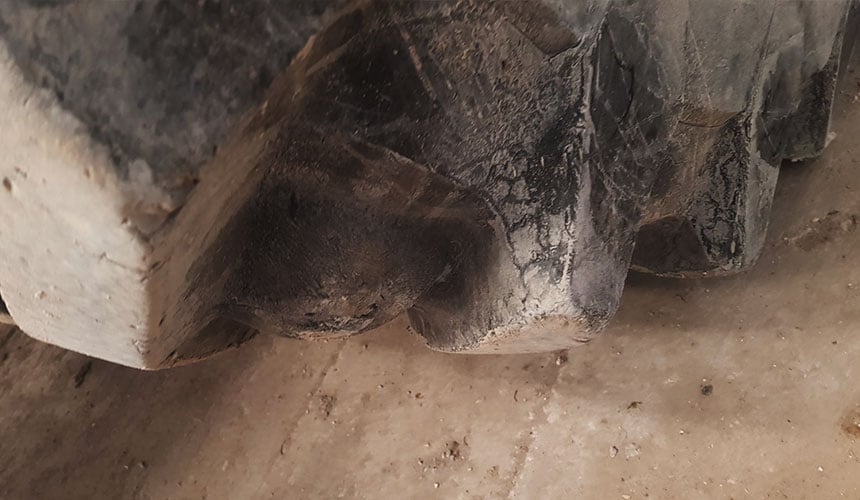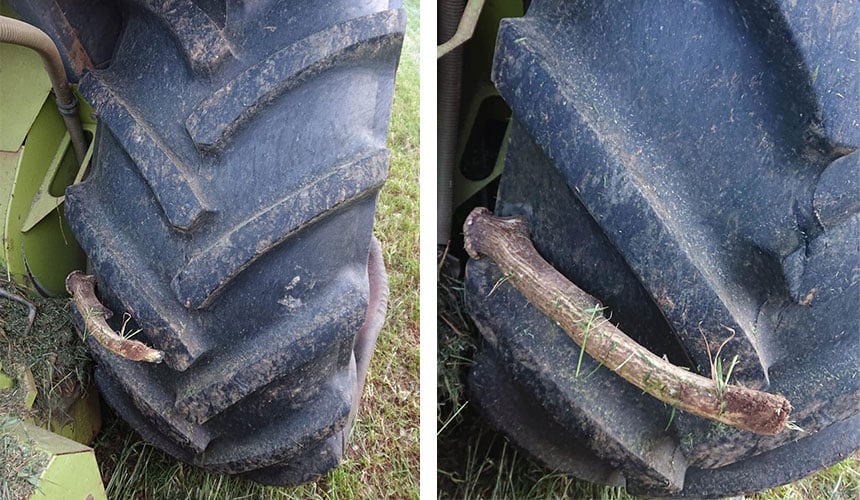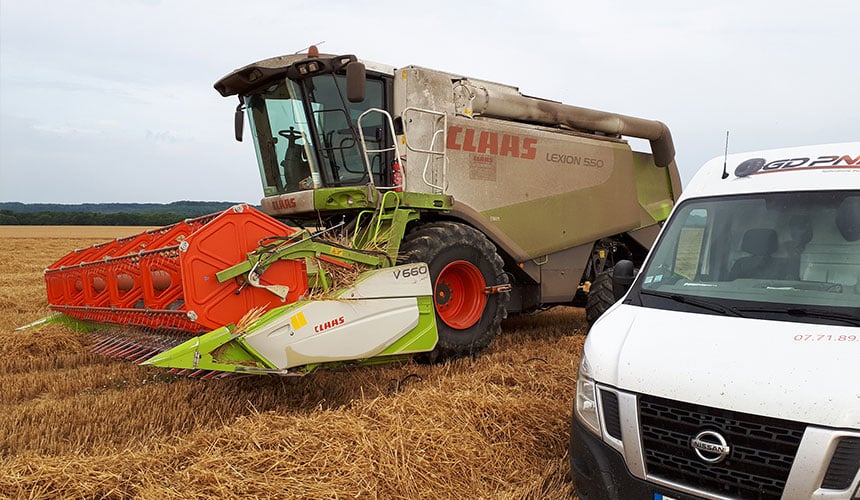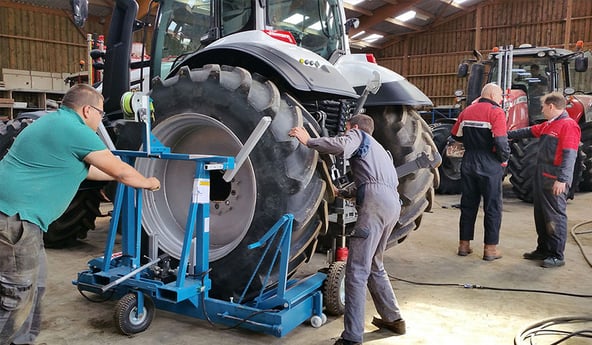When the wheat has ripened and the humidity level is right, the harvest should begin right away and the equipment must be operational so that you can start work immediately. The slightest breakdown or tyre damage is like the sword of Damocles for the farmer, because the harvest is the culmination of his work and there is often a rush to complete the task before any crop deterioration occurs.
You need to move fast, because a minimum amount of rainfall or simply too high a humidity level can lead to losses of up to 5 or 6 quintals per hectare. Equipment breakdown often results in a loss in yield, with a puncture resulting in the harvester being immobilised for between three hours - in the best-case scenario - to two days.
In this article we will explain how best to protect against this type of breakdown.
How to protect against agricultural tyre incidents and avoid breakdowns?
Most punctures occur at the beginning of the harvesting operation simply due to lack of proper tyre maintenance. In general, the problem is triggered at the start of the campaign by what appeared to be minor damage the previous year. A knock or a badly positioned fissure may create an incipient crack that is not visible at the time. As the damage may be accentuated during storage, this incipient crack becomes a real problem at the start of the following harvesting campaign.
A few recommendations for storing agricultural machinery:
- For prevention purposes, tyres should always be stored at recommended working pressure (see tyre manufacturer recommendations)
- Add 400 grs of pressure to avoid any squashing or deformation that the tyre may incur during the immobilisation of your combine harvester.
- Remember to always store tyres in a clean area, away from hydrocarbons and preferably inside.
During machinery maintenance before the harvester is put into service, it is necessary to check and adapt pressure and verify the condition of the tyres and wheels.
If there is a cut on the sidewall or deformation of the tread, this is often a sign that should not be ignored.

It is also necessary to check that the bolts on the rim are tight. If they have become loose and you drive a lot on the road, the rim will vibrate and destroy the bolt threads, the hole will become oval shaped and the rim will have to be replaced, leading to unnecessary costs.
As the most feared risk is a breakdown linked to a puncture, you should always slow down on land running adjacent to the road and look out for rubbish thrown into your fields by drivers (glass bottles, hub caps and all sorts of metal objects which may have sharp edges and be detrimental to your tyres).
When the puncture occurs, your machinery will be immobilised, which is when you must be able to count on your partners.

The first question is how long will it take to repair?
To enable his farmer clients to be as mobile as possible, a good agricultural tyre dealer must be available permanently:
- with equipment and emergency response vehicles
- with a professional and efficient team of technicians.
He must offer you more autonomy and relieve you of the risks and hazards of your harvesting operation.
A quality tyre mechanic must be available, in the best case he gets into his truck and can fix the problem in less than 4 hours.
However, at the beginning of the harvesting season, the chances are that all his trucks have already been deployed, so you may have to wait till the end of the day before he can reach you.

What can you expect from your tyre dealer?
It is important to listen carefully:
Make sure that you describe the problem accurately so that the tyre mechanic arrives with the right equipment, a fully-equipped vehicle, set of wheel chocks to raise the vehicle, inflator, calibrator…
In principle, the dealer should arrive with a new tyre if the damage is extensive or an equivalent second-hand tyre. New tyres are always preferable to be on the safe side, but second-hand tyres that have done 5 or 6 campaigns are often used as a stopgap solution. You can be sure that no tyre dealer will run the risk of bringing you inadequate tyres which would result in him having to come back and repair them for free.

The aim is to go fast, but also to avoid a costly emergency intervention. Good relations with your tyre dealer and loyalty over many years may provide good leverage in negotiating a better price with a faster breakdown service.
In general, the cost will include the call-out charge, 3 to 4 hours of labour and the price of the equipment.
Beware of repairs that are too fast and too cheap, with ill-adapted tyre patches that have the unpleasant habit of falling off after 3 or 4 days. It is often preferable to change the tyre to avoid further immobilisation for several hours.
In the event of tyre damage, why choose new tyres designed for harvesting?
The choice of tyres for your combine harvester is not something you can improvise, because the quality of your work, your comfort, your safety, the preservation of your soil and your savings all depend on the quality of the tyre you choose.
By opting for the latest-generation technology models, you allow your machinery to bear much greater loads. Among those with the most advanced technological features, one category really stands out: VF CFO harvesting tyres.
Guaranteed savings thanks to a high load capacity
IF and VF technology CFO harvesting tyres have a reinforced structure which can bear from 20 to 55% more load than a standard tyre. These CFO (Cyclic Field Operation) harvesting tyres have a casing that is designed to resist the huge variation in the load of the harvesters and the extremely heavy loads, thus guaranteeing optimal reliability of your tyres. In more complicated operating conditions, the importance of CFO tyres increases thanks to their greater load capacity, in particular on sloping fields.
Thanks to the greater flexion of these technological tyres, you can reduce the pressure despite the weight of the loaded machine, the balance of your vehicle is optimised as the contact surface with the ground is much greater. The larger the tyre footprint, the greater your comfort, the more your soil is protected and the less soil compaction risk there is. In addition to these various advantages, using IF or VF CFO tyres will lead to considerable savings. Their high load capacity will effectively allow the harvester to work continuously and avoid multiple trips back and forth with the trailer, reducing your overall fuel consumption throughout the harvesting campaign.

Time savings and greater tractive force
Choosing your harvester tyres well guarantees you a better yield at the end of the campaign, given that they are the only contact between your machinery and the ground. By increasing your tyre footprint, you obtain better traction and save time spent per hectare.
The most efficient solution is to use IF or VF CFO harvesting tyres. Thanks to these, you will be able to reduce pressure in order to avoid excessive soil compaction and to increase the contact surface between the tyre and the ground. Their lugs grip evenly into the ground over their full length, which makes it possible to distribute the tractive force over a larger area of the ground. The tyres will have better grip and you will be able to increase speed to save more time by the end of the day, and as such cover more hectares per day.
Soil preservation first and foremost
Like all harvesting machinery, combine harvesters are heavy machines which can easily cause soil compaction unless they are equipped with adapted tyres. Due to their size, they have a major impact on your soil structure. The more you drive across your plots of land to finish the harvest as quickly as possible, the more your machinery compacts a large surface area. By choosing IF or VF CFO tyres, you limit your machinery’s impact on the ground, which encourages better root development in the next crops planted and optimises future yields.
To take it a step further and increase the profitability of your farm, here is an ebook, downloadable for free, which explains the essential role of your tyres in the optimisation of your productivity.
Most people who read this article have also read some of the following articles:
- 5 essential techniques to optimise your agricultural tyres
- Info to help you know your agricultural tyres better and make savings
- The 3 best techniques for storing your agricultural tyres
- All the secrets of tractor tyres, agricultural tyres or farm tyres
- Understanding the manufacturer’s technical information on agricultural tyres
This information is intended only to make you aware of the technical and functional aspects of agricultural tires and their use. It does not allow you to make a judgment or a definitive conclusion on a given problem. Only your agricultural tire expert is able to make a technical assessment and take a final decision, case by case.
Leave a
commentary
Your email address will not be published.
Required fields are indicated with *








